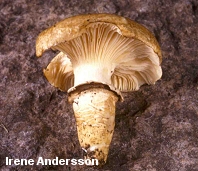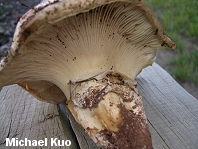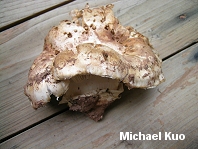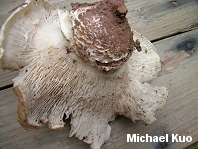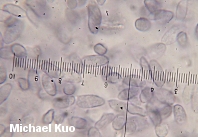| Major Groups > Gilled Mushrooms > Pale-Spored > Catathelasma > Catathelasma imperiale |

|
Catathelasma imperiale [ Basidiomycetes > Agaricales > Tricholomataceae > Catathelasma . . . ] by Michael Kuo Catathelasma imperiale (sometimes spelled "imperialis") is a western, conifer-loving species defined by its large size, its gills (which begin to run down the stem), its white spore print, its stem (long and rooting, with a tapered base), its sticky brownish cap, its mealy odor, and its double ring. Under the microscope, it has elongated, amyloid spores. That, anyway, is how I am defining the species here. Catathelasma ventricosum is very similar; if it occurs in western North America (see my comments on the page for that species), be prepared to have difficulty separating the two species if your field guide author allows a brownish cap and/or mealy odor for Catathelasma ventricosum. Confusion with Tricholoma murrillianum, as well as its close relatives in the Tricholoma caligatum species group, is likely. However, neither of these species has gills that run down the stem, a double ring, or a long and rooting stem base--and the matsutake has a characteristic spicy and fragrant odor. Description: Ecology: Presumably mycorrhizal; growing alone or scattered on the ground under conifers; late summer and fall; common in monsoon season in the Rocky Mountains, where it often grows under Engelmann spruce and subalpine fir; western North America. Cap: 10-40 cm; convex becoming planoconvex or nearly flat; sticky when young (but soon dry); with pressed-down fibers or scales; dark brown to brown, reddish brown, or yellowish brown; the surface often cracking up in maturity. Gills: Running down the stem or beginning to do so; close; whitish or vaguely yellowish, sometimes discoloring grayish with age. Stem: Up to 18 cm long and 8 cm wide; tapering to the base and usually rooting somewhat; sometimes almost completely underground; whitish above the ring; brownish below; with a flaring, double ring in which the upper edge of the upper ring is often lined, and the lower ring is often flimsy or nearly gelatinous. Flesh: White; hard; not changing on exposure. Odor and Taste: Taste strongly mealy; odor strongly mealy. Spore Print: White. Microscopic Features: Spores 10-15 x 4-6 µ; smooth; elongated-elliptical; amyloid. Basidia up to 75 µ long. REFERENCES: (Fries) Singer, 1940. (Saccardo, 1887; Singer, 1978; Smith, Smith & Weber, 1979; Arora, 1986; Phillips, 1991/2005; Lincoff, 1992; Miller & Miller, 2006; Kuo, 2007.) Herb. Kuo 08060508. This site contains no information about the edibility or toxicity of mushrooms. |
© MushroomExpert.Com |
|
Cite this page as: Kuo, M. (2006, October). Catathelasma imperiale. Retrieved from the MushroomExpert.Com Web site: http://www.mushroomexpert.com/catathelasma_imperiale.html |
